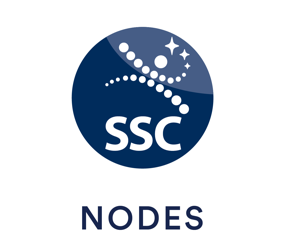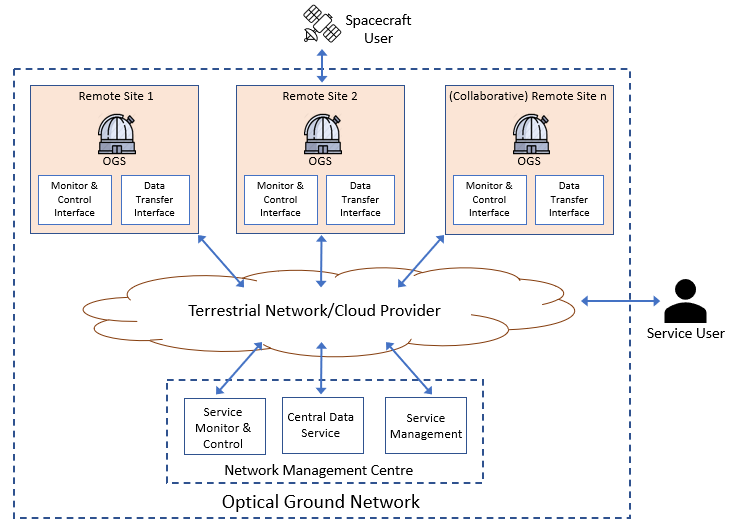
-
StatusOngoing
-
Status date2023-05-12
-
Activity Code6C.033
The target of the NODES project is to develop and demonstrate an optical ground network and corresponding service to enable optical space communications as a future complement to SSC’s existing RF data reception service.
In the product phase of the project the focus has been on system requirements assessment, system architecture and definition of concept of operations. Defining requirements and the procurement of the first optical ground station of the network have also been carried out.
The NODES project has received continued support for Stage 2, which includes the detailed design and implementation of relevant subsystems of the network such as: monitor and control, user management and data delivery. The first station will be commissioned and a second station added to the network. The optical ground network will then be demonstrated.
The operational concept and system design of an optical service requires a different mindset to the traditional RF case. The limited downlink predictability due to the influence of clouds poses the main challenge and will require a highly dynamic scheduling system. The system must also handle large data volumes that may be downloaded in fractions over the globe, and new formulations of service level agreements are needed.
The system requirements and specifications are further challenged by a slow market adoption of optical communication space terminals for the direct-to-Earth scenario, which together with early standardization issues create challenges on ensuring interoperability.
The data service developed through NODES will offer increased satellite data repatriation volumes across its distributed network of optical ground stations. This will in turn help improve our understanding of the Earth, as more and better data will be able to be transferred with low latency.
By making use of the optical band, the NODES service benefits from the large unlicensed bandwidth available which allows for faster time-to-market and higher data rates. Also, the service offered will be more secure, immune to electromagnetic interference and eavesdropping.
The product is a turn-key service offering, where the hardware configuration is abstracted away from the customer. This is accomplished by constructing the hardware, software, interfaces and procedures needed for creating an accessible user experience.
The narrow optical beams from space require high precision reception, which is provided by multiple coordinated subsystems in the optical ground stations (and their counterparts in space). For example, a calibration routine for the telescope assemblies; a pre-defined pointing, acquisition and tracking sequence to allow space-ground discovery; and a fast-steering loop to allow seamless fibre coupling for demodulation.
In the event of severe local atmospheric disturbances impairing the downlink, NODES can adapt and find an alternative to ultimately deliver the spacecraft data to its customer at a pick-up point.
The service is addressing LEO satellites, it is compliant with the CCSDS O3K standard and upgradeable to serve different data rates, modulation schemes, mission purposes and orbits.
The optical ground network has at its heart a Network Management Centre, to orchestrate the whole service by handling the monitor and control, scheduling, data transfer and manage the service.

At least two remote sites are connected to the network and collect the received user data from the spacecraft to the ground station. The payload data is then transferred and delivered to the customer via a terrestrial network controlled by the network management centre, potentially utilizing a cloud service provider.
The activity is divided into two parts, NODES stage 1 and 2. Stage 1 covers the first part of the product phase (PRO1) to develop the system architecture, concept of operations, carry out risk assessment, market prospection, and procurement of the first optical ground station. The reviews include system requirements review (SRR) and preliminary design review (PDR), with MS3 PRO1 completion review (PCR) in Q1 2024, after factory acceptance test of the first optical ground station.
NODES Stage 2 with start in Q2 2023 encompasses the continuation of the product phase followed by a demonstration phase. The commissioning of the first optical ground station and the procurement and commissioning of a second station are planned for this stage, as well as implementation, testing and verification of the optical ground network service. The stage contains a test readiness review (TRR) and a post-test review (PTR). In the demonstration phase, starting in Q4 2024, the service will be demonstrated with at least the two optical ground stations in the network.
.
The activity started in April 2022, kicked-off in August 2022, achieved MS1 system requirements review (SRR) in October 2022, and achieved MS2 preliminary design review (PDR) in March 2023.
The second stage started in April 2023 with the second part of the product phase.
Work currently in progress.


